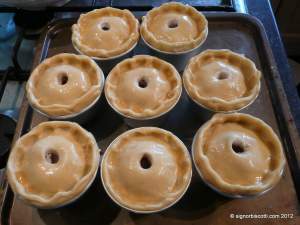 I am sure I am not the only fan of the Great British Bake Off that sits there thinking “I could do that!”, sometimes accompanied by incredulous shouting at the television. I’m equally sure I’m not the only one to daydream about appearing on the show. Well, that may never happen, but I can certainly set myself some of the challenges that the competitors have faced or may face in the future. So it was that I decided to try my hand at Pork Pies.
I am sure I am not the only fan of the Great British Bake Off that sits there thinking “I could do that!”, sometimes accompanied by incredulous shouting at the television. I’m equally sure I’m not the only one to daydream about appearing on the show. Well, that may never happen, but I can certainly set myself some of the challenges that the competitors have faced or may face in the future. So it was that I decided to try my hand at Pork Pies.
There are two main challenges here, apart from the stamina and dedication required to complete the many stages of the recipe!
The first challenge is the hot water pastry. Having done this now, I’d say that its terrors have been much over-rated. The stern warnings found in many recipes that you must work it while it is still warm proved unfounded. The recipe I followed actually stipulated that it be chilled in the fridge before rolling it!
Then there is the challenge of the seasoning. Most recipes simply tell you to add salt and pepper to the meat. But as this is raw meat which you are not going to be able to taste until the pies are cooked, this is a bit perplexing for someone like me. Some recipes suggest frying a mini-burger of the filling, tasting it and adjusting the seasoning. I could see myself having quite a few fry-ups before I got the seasoning right, adding yet more time to an already lengthy process, and also adding to my anxiety levels. Fortunately I found a recipe that made a concrete suggestion for the seasoning, and I found this to be spot on.
I consulted half a dozed recipes in preparation for this bake. In the end I used the one by Richard Bertinet, from his wonderful Pastry book, following it more or less to the letter. If you care about pastry you should definitely buy this book, but you can also find the recipe on line at Stylist Magazine.
Bertinet’s method for making hot water pastry is rather unusual. After the standard first stage of mixing hot water and fat into the flour, he recommends leaving it to rest for an hour. It is then briefly worked, before being chilled for at least half an hour. Very different from the normal recommendation to work the dough while it is still warm for fear it gets too hard. In fact, even after its chilling, the dough was still soft and easy to work with. A revelation. Of course, in a sense I have to admit that I still haven’t done the GBBO hot water crust technical challenge in the strict sense of the term.
The main departure I made from Bertinet’s recipe was in the seasoning. He specified the following:
- 2 anchovies (I don’t like anchovies)
- 2 tablespoons chopped fresh sage
- 1/2 nutmeg grated
- Salt and pepper (yes, even my hero is in that camp)
Following Nigel Slater’s recipe, I substituted the following seasoning:
- 4 sage leaves, chopped
- 3 tablespoons chopped parsley
- 1/4 teaspoon ground mace
- 1/4 teaspoon ground nutmeg
- 1/4 teaspoon ground white pepper
- 1/2 teaspoon coarsely ground black pepper
- 1/2 teaspoon fine sea salt
This worked well. The resulting pies were pleasantly seasoned, but not overly so. If your bacon is very salty, you might want to reduce the salt. Of course you could always start with something like this seasoning, and use the mini-burger fry-up method to check it.
 Another tip I took from Nigel Slater was to chop the meat by hand rather than mince it. With a sharp knife, I found it didn’t take too long to do this. I think I cut it up rather more coarsely than the 5mm dice he suggested, but nevertheless the clearly defined chunks of meat in the final pies were rather pleasing.
Another tip I took from Nigel Slater was to chop the meat by hand rather than mince it. With a sharp knife, I found it didn’t take too long to do this. I think I cut it up rather more coarsely than the 5mm dice he suggested, but nevertheless the clearly defined chunks of meat in the final pies were rather pleasing.
Once the meat was chopped, I scattered the seasoning over it in the bowl and mixed everything together by hand until the herbs looked evenly distributed. I figured that by then the spices would be evenly distributed too.
Bertinet’s recipe uses dariole moulds to form the pies. As he himself indicated, getting the pastry to line these evenly is a challenge. You will probably find yourself with a mass of seemingly unmanageable folds. But don’t get hung up on this. This pastry doesn’t seem to mind being handled, so you can use your fingers to press and mould it into position. Start by getting the pastry more or less central, then make sure it is pressed well into the base. Then press it out and around the sides, redistributing it as necessary. Aim to have between .5 and 1cm protruding above the rim.
 For the holes in the lids, I started them by wiggling a skewer, and then enlarged them with the end of a wooden spoon dipped in flour. You need quite a large hole in order to pour the liquid jelly in later.
For the holes in the lids, I started them by wiggling a skewer, and then enlarged them with the end of a wooden spoon dipped in flour. You need quite a large hole in order to pour the liquid jelly in later.
Talking of the jelly, that is the final challenge! A plastic syringe would probably help. I was hoping my gravy baster would do the job, but it kept releasing the liquid at the wrong moment. So I used a small jug. I did end up with quite a lot of liquid on my worktop, and also on the pie tops. I simply tipped this off, and it didn’t seem to adversely affect the finished pies. However you do it, you need to proceed slowly and give each addition time to drain into the pie before adding any more. You may not need as much as the recipe states; it just depends on how much your meat has shrunk.
So, that’s that Great British Baking Challenge ticked off; on to the next one! Would I make pork pies again? Probably. They looked good and tasted good. But as someone once almost said, “Life is too short to stuff a pork pie”, so I probably won’t be doing it that often.
So what was the next challenge I set myself? Portuguese Custard Tarts. Almost as time-consuming and fiddly as the pork pies. Am I mad, or what?
 I am submitting my pork pies to Tea Time Treats, where the challenge this month is Picnic Pies. Kate from What Kate Baked is the host this month, and she will publish the round-up of entries on the 1st September 2012. Many thanks to Kate and Karen for all their hard work and enthusiasm in running Tea Time Treats!
I am submitting my pork pies to Tea Time Treats, where the challenge this month is Picnic Pies. Kate from What Kate Baked is the host this month, and she will publish the round-up of entries on the 1st September 2012. Many thanks to Kate and Karen for all their hard work and enthusiasm in running Tea Time Treats!

Perfette….io le adoro, per un periodo della mia vita ho vissuto di pie…provero` a farle!
francesca
Ciao Francesca, e grazie. Posso immaginarmi vivendo di pie, e diventando sempre piu’ grasso.
In awe of these. After the last few Bake off episodes I’ve got a list of things to try (including the retro classics rum babas!)
You should give them a go. If you’ve got 5 or six hours to spare. Rum Babas might be quicker!
These look absolutely amazing! Nothing beats a good pork pie – am bookmarking this to make for my boyfriend 🙂
Aw, I’m honoured. I hope the carnivorous bf likes them.
I am super seriously impressed! Thank you ever so much for entering these perfect pies into TTT!
Thanks Kate. Thanks to TTT for spurring me to make them.
I’m dropping by via TTT. Look at that filling, these pie looks great!
Thanks Mich! Mr Bertinet’s recipe is a great one.
I love british pies…¡¡ My favorites are this pork pies, kidney pie and Christmas mince pies
I’m with you on all those! And bakewell tarts, and probably a few more I could mention.
Congratulations on using Richard Bertinet’s pork pie recipe. I have looked at dozens of recipes and all of them require you to mould the pastry into container or mould before it cools and if you don’t you are in trouble – the pastry will crack and is very difficult to use.
In fact in one edition of the gbbo where Mr Hollywood was demonstrating hot water crust pastry he cunningly swapped pastry half way through when it all started to go wrong.
So what is Bertinet’s secret? Easy, he mixes an egg into the flour before the addition of the lard and water. And then all issues regarding speed of work go away. In fact you actually chill the pastry before rolling. So why, and I would really like to know, don’t all recipes for hot water crust pastry do it his way?